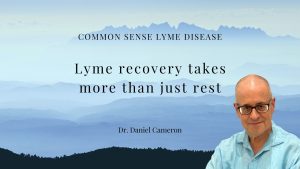Call for your appointment today 914-666-4665 | Mt. Kisco, New York

More than half of the cases were from three countries: 16 (25.4%) from Germany, 9 (14.3%) from Switzerland, and 8 (12.7%) from France. Five cases (8%) were from the United States, notes Garkowski from the Medical University of Białystok in Poland. [1]
Many of the cases involved relatively young patients, with more than 50% under the age of 50. The authors identified 15 pediatric cases, noting the youngest to be 4 years of age. Patients ranged between 4 and 77 years old with a median age of 46. Males represented 54% of all the cases.
The most common cerebrovascular manifestation of LNB was ischemic stroke (76.1%), followed by [transient ischemic attack] (11.4%), according to Garkowski. [1] “The posterior circulation was affected alone in 37.8% of patients, the anterior circulation in 24.4% of patients, and in 37.8% of cases, posterior and anterior circulations were affected simultaneously.”
A complete response to antibiotic treatment occurred in 75% of the patients. The authors defined a complete response as, “halted progression of the disease and no recurrence of cerebral ischemia or recuperation from neurological deficits.” The mortality rate was 4.7%. The outcome for the remaining 20% was incomplete or incomplete with residual neurologic deficit.
The authors suggest prompt evaluation of prodromal syndromes. “The lack of awareness of this manifestation of LNB might result in the delay of diagnosis, which might lead even to the patient’s death,” warns Garkowski. [1] “Several weeks/months before stroke onset, prodromal symptoms suggesting LNB [Lyme neuroborreliosis], such as meningitis, cranial neuritis or radiculoneuritis, should prompt extensive diagnostics including CSF [cerebrospinal fluid] examination.”
Takeaway: Physicians should consider cerebral vasculitis and stroke due to Lyme neuroborreliosis in patients living in or having visited areas endemic for tick-borne diseases, and in those individuals who don’t have any cardiovascular risk factors but who exhibit stroke-like symptoms with no known cause.
More on the topic:
At least 50% of patients with Lyme neuroborreliosis remain ill years after treatment
What happens to the brain during acute Lyme neuroborreliosis?
References:
- Garkowski A, Zajkowska J, Zajkowska A, et al. Cerebrovascular Manifestations of Lyme Neuroborreliosis-A Systematic Review of Published Cases. Front Neurol. 2017;8:146.





hi doc 😉
very interesting article! around 15 years ago when i was still trying to get a correct diagnosis for my MISDIAGNOSIS of chronic lyme, i had a mri done.
it showed a MINI-STROKE with “old blood”. since i was misdx for 35 years, this stroke could have occurred during this time period.
is there some type of guideline to determine how long it’s been since any patient had a stroke? thanks doc!
betty gordon
iowa fan of yours 😉 didn’t get a chance to introduce myself at fall st. paul lda conference!
Good question. At least we are having a conversation.
I have had Lyme disease with Ehrlichia since 2012. An MRI said I had a stoke and a spinal tap revealed rare white blood cells. I am still sick after being put on a PICC line and 4 1/2 years of antibiotics. I suffer confusion, headaches, stiff neck, nausea,and extreme weaknesses and fatigue, nausea and severe brain fog. My head hurts so bad at the back of my head. I would like to be evaluated by the Dr. I have made no improvement in my condition. My skin burns and stings.
Please get back with me.
It is difficult to tell whether a different approach might work. Feel free to call the office at 914 666 4665 if you have any questions.
I’m very interested in understanding more. Feb 2017 I had at stroke at 42 years old and the 0nly thing I have going on with my health was a newer (~6 month) infection with Lyme. All my doctors are not in alignment with my neurologist who said Lyme caused my stroke. I’m at odds wondering if that is the true cause of the stroke.
It can be difficult to determine the cause of a stroke. You may find that well trained doctors can reach different conclusions. Make sure you are thoroughly evaluated for all causes. You might benefit from a second look a a tick borne illness.
I was diagnosed in 2013 with Lyme disease but I believe based on my symptoms that mostly have gone away after 4 years of IV antibiotics that I got lyme disease as long ago as 1995 or before. I had an MRI done in 2016 which showed an old stroke surrounded by a large area of gliosis. My blood vessels were clean at the time of the MRI without any athlerosclerosis. Is it possible that the stroke occurred slowly over time? Or did it have to have occurred suddenly? I had no obvious symptoms such as weakness on the opposite side so I have no idea when it occurred
It is hard to tell if a white spot is demyelination or a stroke. Your doctors may offer insight.
I live in West Tx.I was diagnosed with chronic Lyme in 2008 believe to then have a 2nd infection, 1sts one in 1997. The 1st see of August 2018I had 5 new tick bites from the East in TN,NC,SC. Whithin 2 to 4 weeks I started having n nueroligical symptoms that increased daily. I have had 3 strokes in a week and a half. Im only 53 single mom off a13 yr old. Lyme is not recognized here, no one will listen or is helping me. I desperately need a doc too treat me. I’m begging for your help,, please!!!
I have written a couple Lyme disease science blogs to better understand the clinical presentations where stroke was described as a manifestations of Lyme disease. It is important to always rule out other cases of stroke. You should try and find a doctor experienced in treating Lyme disease as part of your evaluation. It can be hard to find an experienced doctor in many areas of the country.
I hope by now that your child has seen a Lyme doctor, and that the strokes are gone. I would suggest finding a LLMD at ILADS.com. There is an area where you can find a doctor in your area = Tools and Resources. Prayers for you and your child.
My husband got lyme disease three years ago. Within the first year it came back with more severe symptoms. Was treated again with antibiotics. Within the 2nd year he came down with type 2 diabetes suddenly. Within the third year he had a stroke. Has recovered for the most part but still has hearing problems and neurologic issues. I believe all these illnesses is a result of him contracting Lyme Disease
My friend just died from a stroke at age 61. She had Lyme Disease and was dealing with a moldy rental.
I am sorry for your loss.